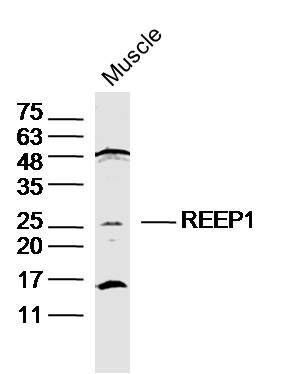REEP1 Polyclonal Antibody
Purified Rabbit Polyclonal Antibody (Pab)
- SPECIFICATION
- CITATIONS
- PROTOCOLS
- BACKGROUND

Application
| WB, IHC-P, IHC-F, IF, ICC, E |
|---|---|
| Primary Accession | Q9H902 |
| Reactivity | Rat, Pig, Dog, Bovine |
| Host | Rabbit |
| Clonality | Polyclonal |
| Calculated MW | 22 KDa |
| Physical State | Liquid |
| Immunogen | KLH conjugated synthetic peptide derived from human REEP1 |
| Epitope Specificity | 53-150/201 |
| Isotype | IgG |
| Purity | affinity purified by Protein A |
| Buffer | 0.01M TBS (pH7.4) with 1% BSA, 0.02% Proclin300 and 50% Glycerol. |
| SUBCELLULAR LOCATION | Membrane. Mitochondrion membrane; Multi-passmembrane protein. Endoplasmic reticulum. |
| SIMILARITY | Belongs to the DP1 family. |
| SUBUNIT | Interacts with SPAST and ATL1; it preferentiallyinteracts with SPAST isoform 1. Interacts (via C-terminus) withmicrotubules. Interacts with odorant receptor proteins |
| Post-translational modifications | Belongs to the DP1 family. |
| DISEASE | Defects in REEP1 are the cause of spastic paraplegia autosomal dominant type 31 (SPG31) [MIM:610250]. Spastic paraplegia is a neurodegenerative disorder characterized by a slow, gradual, progressive weakness and spasticity of the lower limbs. Rate of progression and the severity of symptoms are quite variable. Initial symptoms may include difficulty with balance, weakness and stiffness in the legs, muscle spasms, and dragging the toes when walking. In some forms of the disorder, bladder symptoms (such as incontinence) may appear, or the weakness and stiffness may spread to other parts of the body. |
| Important Note | This product as supplied is intended for research use only, not for use in human, therapeutic or diagnostic applications. |
| Background Descriptions | Transport of G protein-coupled receptors (GPCRs) to the cell surface membrane is critical for receptor-ligand recognition. Mammalian GPCR odorant receptors (ORs), when heterologously expressed in cells, are poorly expressed on the cell surface. REEP1 (receptor expression-enhancing protein 1), is a 201 amino acid multi-pass mitochondrion membrane protein that belongs to the DP1 family. REEP1 interacts with odorant receptor proteins and may enhance the cell surface expression of odorant receptors. Mutations in the REEP1 gene are the third most common cause of hereditary spastic paraplegia (HSP) after spastin and atlastin gene mutations. Mutations in the REEP1 gene also cause spastic paraplegia autosomal dominant type 31, a neurodegenerative disorder. The REEP1 gene is conserved in chimpanzee, dog, cow, mouse, rat, chicken, zebrafish, A.thaliana and rice, and maps to human chromosome 2p11.2. |
| Gene ID | 65055 |
|---|---|
| Other Names | Receptor expression-enhancing protein 1, Spastic paraplegia 31 protein, REEP1, C2orf23, SPG31 {ECO:0000303|PubMed:23969831} |
| Dilution | WB=1:500-2000,IHC-P=1:100-500,IHC-F=1:100-500,ICC=1:100-500,IF=1:100-500,ELISA=1:5000-10000 |
| Storage | Store at -20 ℃ for one year. Avoid repeated freeze/thaw cycles. When reconstituted in sterile pH 7.4 0.01M PBS or diluent of antibody the antibody is stable for at least two weeks at 2-4 ℃. |
| Name | REEP1 |
|---|---|
| Synonyms | C2orf23, SPG31 {ECO:0000303|PubMed:23969 |
| Function | Required for endoplasmic reticulum (ER) network formation, shaping and remodeling; it links ER tubules to the cytoskeleton. May also enhance the cell surface expression of odorant receptors (PubMed:20200447). May play a role in long-term axonal maintenance (PubMed:24478229). |
| Cellular Location | Membrane. Mitochondrion membrane; Multi-pass membrane protein. Endoplasmic reticulum Note=Localizes to endoplasmic reticulum tubular network |
| Tissue Location | Expressed in circumvallate papillae and testis. |

Thousands of laboratories across the world have published research that depended on the performance of antibodies from Abcepta to advance their research. Check out links to articles that cite our products in major peer-reviewed journals, organized by research category.
info@abcepta.com, and receive a free "I Love Antibodies" mug.
Provided below are standard protocols that you may find useful for product applications.
If you have used an Abcepta product and would like to share how it has performed, please click on the "Submit Review" button and provide the requested information. Our staff will examine and post your review and contact you if needed.
If you have any additional inquiries please email technical services at tech@abcepta.com.













 Foundational characteristics of cancer include proliferation, angiogenesis, migration, evasion of apoptosis, and cellular immortality. Find key markers for these cellular processes and antibodies to detect them.
Foundational characteristics of cancer include proliferation, angiogenesis, migration, evasion of apoptosis, and cellular immortality. Find key markers for these cellular processes and antibodies to detect them. The SUMOplot™ Analysis Program predicts and scores sumoylation sites in your protein. SUMOylation is a post-translational modification involved in various cellular processes, such as nuclear-cytosolic transport, transcriptional regulation, apoptosis, protein stability, response to stress, and progression through the cell cycle.
The SUMOplot™ Analysis Program predicts and scores sumoylation sites in your protein. SUMOylation is a post-translational modification involved in various cellular processes, such as nuclear-cytosolic transport, transcriptional regulation, apoptosis, protein stability, response to stress, and progression through the cell cycle. The Autophagy Receptor Motif Plotter predicts and scores autophagy receptor binding sites in your protein. Identifying proteins connected to this pathway is critical to understanding the role of autophagy in physiological as well as pathological processes such as development, differentiation, neurodegenerative diseases, stress, infection, and cancer.
The Autophagy Receptor Motif Plotter predicts and scores autophagy receptor binding sites in your protein. Identifying proteins connected to this pathway is critical to understanding the role of autophagy in physiological as well as pathological processes such as development, differentiation, neurodegenerative diseases, stress, infection, and cancer.


